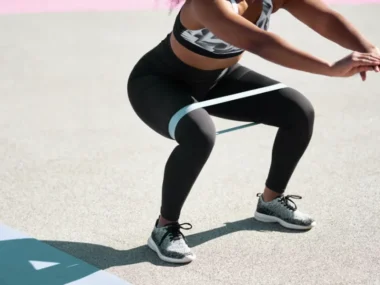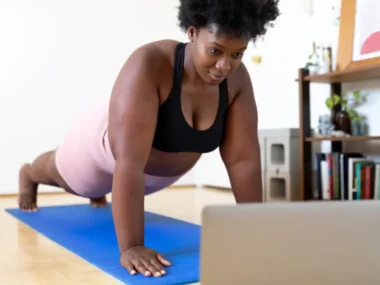Thunderbolt Pose (Vajrasana) is a starter yoga pose majorly connected with Hatha yoga. It is an asana, which is a body posture. This yoga pose is commonly used for meditation purposes.
There is fewer stretching involved in this pose, though it strengthens the back and core through correct posture. Vajrasana also opens up the chest and shoulders, provisioning breathing patterns easy and fluid during meditation in this pose. If you have sensitive knees you may need to tweak this pose, but you will still get the same benefits.
This pose is awesome for persons who need to relax their body and mind. It can be done almost anywhere, making it a suitable pose for those who do meditative yoga on the go or as needed. No equipment is needed, though a yoga mat may provide extra comfort and support for the legs.
Benefits
Thunderbolt pose holds both physical and mental benefits. Though it appears simple, this beginner-friendly yoga pose has been known to significantly impact yogis who perform it.
Physically, Vajrasana requires specific posture. With the spine upright, this pose strengthens the back. This can improve posture during your day-to-day life. If you sit at a desk for many hours during the day, this pose can help you correct slouching and drooping in your seat. In this way, it may alleviate neck and back pain associated with sedentary desk jobs.
Thunderbolt also improves core strength. Tighten your core during this pose to engage your stomach muscles. This provides a solid foundation to perform more advanced yoga poses that rely on your core.
Mentally, this yoga pose invites deep breathing exercises and meditation. When done together, Thunderbolt pose, deep breathing, and meditation can provide mental clarity and reduced stress.
Step-by-Step Instructions on How To Do Thunderbolt Pose
When you are first introduced to Thunderbolt pose, you may wonder how this pose is different from kneeling. Though this pose is simple and suitable for beginners, people of all experience levels must follow the same instructions to enter into this kneeling pose accurately.
1. Kneel down onto your yoga mat or soft surface. Sit on your knees with your feet relaxed. Do not place the ball of the foot onto the ground.
2. Cross your big toes so that your feet create a support for your bottom to rest on.
3. Place your hands in front of you and on your knees. Your arms should be relaxed instead of tense. You can face your palms up or down depending on what feels comfortable to you. Pull the hands into a praying position to encourage the flow of energy.
4. Actively straighten out your spine so that your back is perpendicular to the floor. Your back should not be rounded. Pull your shoulders back and tighten your core. Pull your navel into your spine.
5. As you set your gaze forward, engage your neck to support your head. Your head should not hang down.
6. Focus on your breathing. Take deep breaths in and release them out slowly. As you inhale and exhale, your chest will expand and collapse. Continue to keep your back straight rather than slouching in as your breathing tugs at your posture.
7. Close your eyes and bring your focus to your inner world.
8. Try to stay in this position for 1-2 minutes. If meditating, continue for 5-10 minutes or as long as needed.
Frequent Mistakes
Vajrasana is an excellent pose for beginners because it is one you can master right away. This feeling of accomplishment may encourage you to try other poses and continue with your yoga practice. Since this kneeling pose is commonly used in Hatha yoga sequences, make sure to avoid these common mistakes.
Letting your head hang down
Another common posture mistake is not supporting the weight of your head evenly on your neck. Focus your gaze straight ahead rather than looking down, which causes your head to hang down and places strain on the neck.
Rounding your back
This pose places a heavy emphasis on posture. You may have a certain idea about what you consider to be good posture, but Thunderbolt pose is very specific about its own expectation. Rounding your back into a slouched, relaxed position may be comfortable, but this can actually cause neck and back pain. Keep your spine erect to get the most out of this pose.
Remaining too stiff
You should not feel pain while maintaining this kneeling position. Some parts of your body — such as your core, shoulders, and back — should be engaged, but your overall body shouldn’t be tight or stiff. If you feel stuck in a certain position, release the pose and relax your body.
Releasing the position too soon
Some yoga poses can only be maintained for a few seconds or minutes. Thunderbolt pose is designed to be enjoyed for a longer period of time. To experience the full benefits, try to stay in the pose for at least 30 seconds. When used for meditation purposes, aim for at least 5 minutes.
Tweaks and Variations
Need a TWEAK?
Vajrasana requires some flexibility in the legs in order to hinge them and sit on your knees. If you are unable to get into this position, try extending your legs in front of you as demonstrated by Staff Pose (Dandasana). This will remove some of the pressure off your knees and hamstrings.
When starting a yoga practice, everyone has to start somewhere. If Vajrasana makes you feel uncomfortable, start with another sitting yoga pose like Siddhasana. Some great starter poses include Seated Forward Bend (Paschimottanasana) and Head-to-Knee Pose (Janu Sirsasana).
READY for a Challenge?
Vajrasana is often made more challenging by bringing the arms behind the back. This opens up your shoulders even further and even engages the wrists. To do this, bring your arms around your back. Roll your shoulder and elbow slowly to avoid injury. Then, place your hands together in a praying position.
To make Vajrasana more challenging, bend your back so that your head is resting against the floor as demonstrated in Little Thunderbolt Pose (Laghu Vajrasana). This will yield a deeper stretch in your back, core, and quads. It will also open up your chest even further.
If you’re ready for the next level from Vajrasana, you can ease into more challenging poses that still improve posture, offer meditative benefits, and engage your core. Some average poses include Locust Pose (Salabhasana) and Ankle Pose (Agnistambhasana).
Precautions
Vajrasana is normally a safe pose to perform. Keep your back, neck, and head supported to avoid injuries.
Your knees will be pressed against the floor in this pose. If this causes pain, try placing a folded yoga mat under your knees and shins.





